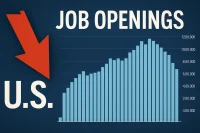The US job market is showing signs of a slowdown in worker mobility.
The number of people switching jobs has dropped significantly, raising concerns about the long-term impact on wages, career growth, and overall economic health.
The Decline in Job Transitions
Recent data from Recruitonomics reveals a sharp decline in job switching:
- In mid-2022, resignations hit a peak of 4.3 million per month.
- By late 2024, that number fell to 3.3 million.
- This drop is even lower than pre-pandemic levels.
Workers are choosing to stay put rather than take the risk of switching jobs. This shift marks a stark contrast to the “Great Resignation“ that defined the early 2020s.

Why Are Workers Staying Put?
Several factors are influencing this trend:
- Economic Uncertainty – Concerns over inflation, interest rates, and a potential recession have made workers cautious.
- Job Stability Over Pay Raises – Many employees now prioritize long-term security over short-term salary boosts.
- Employer Retention Efforts – Companies are offering better benefits and internal promotions to keep employees from leaving.
This shift towards job stability may reduce overall wage growth, as job-switchers typically see higher salary increases than those who stay with the same employer.
Hiring? Post jobs for free with WhatJobs
How This Affects Hiring and Wage Growth
The decline in job mobility has ripple effects across the labor market:
- Fewer Open Positions – When fewer people leave, fewer job openings are available for new hires.
- Slower Wage Growth – In previous years, job-switchers drove wage increases, but with fewer people moving, salary bumps are becoming less frequent.
- Reduced Career Progression – Employees staying in one job too long may see slower skill development and fewer advancement opportunities.
While this trend offers stability, it may also make the job market less dynamic and reduce upward mobility for many workers.
Need Career Advice? Get employment skills advice at all levels of your career
What’s Next for the Labor Market?
The shift to “The Great Stay” is reshaping employment trends.
Whether this pattern continues depends on multiple factors, including economic conditions, technological advancements, and shifts in employer strategies.
For now, workers seem more inclined to stay put, choosing security over change in an evolving job market.
FAQs
Why are so many employees quitting?
Employees are quitting due to low pay, burnout, and shifting priorities. Many feel undercompensated, especially as inflation rises, pushing them to seek better salaries and benefits elsewhere. The demand for flexibility has also grown, with remote work showing employees they don’t need to be tied to rigid office schedules. Those forced back into traditional workplaces often choose to leave for jobs offering better work-life balance.
Burnout is another key factor, with many employees unwilling to tolerate high-stress environments. Toxic workplace culture, poor management, and lack of career growth make quitting an attractive option, particularly for Millennials and Gen Z, who value meaningful work. Platforms like Glassdoor have also made it easier for workers to expose bad employers, pressuring companies to improve conditions.
A competitive job market has further fueled resignations, with businesses offering better pay and perks to attract talent. Employees see more opportunities and are taking advantage of them. Companies failing to adapt—whether through better compensation, flexibility, or culture—risk losing staff to employers who meet evolving expectations. With more choices than ever, workers are prioritizing their well-being and career satisfaction over loyalty to companies that don’t support them.
Why is job hopping so common?
Job hopping has become increasingly common as workers seek better pay, career growth, and work-life balance. Many employees, especially younger generations, see frequent job changes as the fastest way to increase their salaries. Unlike previous generations, who often relied on company loyalty for raises and promotions, today’s workforce realizes that switching jobs often results in higher earnings than waiting for incremental raises from the same employer.
Career advancement is another major factor. Many employees feel stuck in roles with limited opportunities for growth. If a company doesn’t offer clear paths for skill development or promotions, workers are more likely to leave for a position that does. With industries evolving rapidly, employees also seek new challenges and diverse experiences to stay competitive in the job market.
The rise of remote work and the gig economy has made job switching easier than ever. With more companies offering flexible work arrangements, employees are no longer tied to a single employer for stability. Instead, they explore opportunities that offer greater autonomy, better benefits, or alignment with their personal values.
Ultimately, job hopping reflects a shift in how workers view employment. Rather than staying loyal to one company, they prioritize their own financial, professional, and personal growth.
What is the big stay in 2024?
The “Big Stay” in 2024 refers to a shift in the job market where employees are choosing to remain in their current roles rather than actively seeking new opportunities. After years of high quit rates during the Great Resignation, workers are now prioritizing job stability due to economic uncertainty, rising interest rates, and a cooling labor market. With fears of layoffs in certain industries and fewer job openings compared to the post-pandemic hiring boom, many employees feel safer staying put rather than risking a move.
Companies have also played a role in this shift by improving retention efforts. Many businesses, recognizing the cost of high turnover, have started offering better salaries, flexible work arrangements, and career development opportunities to encourage employees to stay. Some workers who previously considered job hopping for better pay or benefits are now finding those incentives within their current organizations.
Additionally, job seekers have become more cautious. The rapid hiring spree of 2021 and 2022 has slowed, and workers are now weighing job changes more carefully, prioritizing long-term security over short-term gains. As a result, 2024 is seeing fewer resignations, marking a departure from the high turnover trends of previous years.
Are more people switching jobs?
Fewer people are switching jobs in 2024 compared to the peak of the Great Resignation. The job market has cooled, and many workers are prioritizing stability over chasing new opportunities. Economic uncertainty, slower hiring in some industries, and concerns about layoffs have made employees more cautious about leaving their current positions. Unlike previous years, when job hopping often led to significant pay increases, many workers now see staying put as a safer choice.
However, job switching is still happening, especially in high-demand fields such as tech, healthcare, and finance. Skilled professionals in these industries continue to receive competitive offers, leading some to make strategic moves. But overall, the rate of voluntary job changes has declined as companies tighten their hiring budgets and workers seek job security.
Employers have also stepped up efforts to retain talent, offering better pay, career development, and flexible work arrangements. This has reduced the incentive for employees to look elsewhere. While job switching isn’t disappearing, 2024 is seeing a shift toward what’s being called the “Big Stay,” where more workers are opting for stability instead of frequent job changes.




